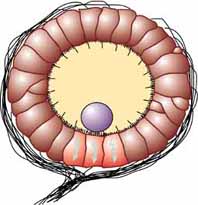statocysts on:
[Wikipedia]
[Google]
[Amazon]

 The statocyst is a balance sensory receptor present in some aquatic
The statocyst is a balance sensory receptor present in some aquatic

 The statocyst is a balance sensory receptor present in some aquatic
The statocyst is a balance sensory receptor present in some aquatic invertebrate
Invertebrates are a paraphyletic group of animals that neither possess nor develop a vertebral column (commonly known as a ''backbone'' or ''spine''), derived from the notochord. This is a grouping including all animals apart from the chordate ...
s, including bivalves, cnidaria
Cnidaria () is a phylum under kingdom Animalia containing over 11,000 species of aquatic animals found both in freshwater and marine environments, predominantly the latter.
Their distinguishing feature is cnidocytes, specialized cells that ...
ns, ctenophora
Ctenophora (; ctenophore ; ) comprise a phylum of marine invertebrates, commonly known as comb jellies, that inhabit sea waters worldwide. They are notable for the groups of cilia they use for swimming (commonly referred to as "combs"), and ...
ns, echinoderm
An echinoderm () is any member of the phylum Echinodermata (). The adults are recognisable by their (usually five-point) radial symmetry, and include starfish, brittle stars, sea urchins, sand dollars, and sea cucumbers, as well as the s ...
s, cephalopods, and crustacean
Crustaceans (Crustacea, ) form a large, diverse arthropod taxon which includes such animals as decapods, seed shrimp, branchiopods, fish lice, krill, remipedes, isopods, barnacles, copepods, amphipods and mantis shrimp. The crustacean group can ...
s. A similar structure is also found in ''Xenoturbella
''Xenoturbella'' is a genus of very simple bilaterians up to a few centimeters long. It contains a small number of marine benthic worm-like species.
The first known species ('' Xenoturbella bocki'') was discovered in 1915 by Sixten Bock, but it w ...
''. The statocyst consists of a sac-like structure containing a mineralised mass (statolith) and numerous innervated sensory hairs (seta
In biology, setae (singular seta ; from the Latin word for " bristle") are any of a number of different bristle- or hair-like structures on living organisms.
Animal setae
Protostomes
Annelid setae are stiff bristles present on the body. ...
e). The statolith's inertia
Inertia is the idea that an object will continue its current motion until some force causes its speed or direction to change. The term is properly understood as shorthand for "the principle of inertia" as described by Newton in his first law ...
causes it to push against the setae when the animal accelerates. Deflection of setae by the statolith in response to gravity
In physics, gravity () is a fundamental interaction which causes mutual attraction between all things with mass or energy. Gravity is, by far, the weakest of the four fundamental interactions, approximately 1038 times weaker than the stro ...
activates neuron
A neuron, neurone, or nerve cell is an electrically excitable cell that communicates with other cells via specialized connections called synapses. The neuron is the main component of nervous tissue in all animals except sponges and placozoa. ...
s, providing feedback to the animal on change in orientation and allowing balance to be maintained.
In other words, the statolith shifts as the animal moves. Any movement large enough to throw the organism off balance causes the statolith to brush against tiny bristles which in turn send a message to the brain to correct its balance.
It may have been present in the common ancestor of cnidarians and bilaterians.
Hearing
In cephalopods like squids, statocysts provide acochlea
The cochlea is the part of the inner ear involved in hearing. It is a spiral-shaped cavity in the bony labyrinth, in humans making 2.75 turns around its axis, the modiolus. A core component of the cochlea is the Organ of Corti, the sensory or ...
-like mechanism to hear. As a result, the longfin inshore squid for instance can hear low-frequency sounds between 30 and 500 Hz when the water temperature is above 8 °C.
See also
*Accelerometer
An accelerometer is a tool that measures proper acceleration. Proper acceleration is the acceleration (the rate of change of velocity) of a body in its own instantaneous rest frame; this is different from coordinate acceleration, which is acc ...
*Inertial guidance
An inertial navigation system (INS) is a navigation device that uses motion sensors ( accelerometers), rotation sensors ( gyroscopes) and a computer to continuously calculate by dead reckoning the position, the orientation, and the velocity ...
*Müllerian vesicle
Loxodidae is a family of karyorelict ciliates.
Loxodidae members possess an elongated, laterally flattened shape. They share two key characters: a beak-like anterior rostrum interrupting the perioral kineties, and peculiar cytoplasmic organelle ...
, similar structure in loxodid ciliates
*Otolith
An otolith ( grc-gre, ὠτο-, ' ear + , ', a stone), also called statoconium or otoconium or statolith, is a calcium carbonate structure in the saccule or utricle of the inner ear, specifically in the vestibular system of vertebrates. The sa ...
, an equivalent structure in vertebrates.
*Statocyte Statocytes are gravity-sensing ( gravitropic) cells in higher plants. They contain amyloplasts-statoliths – starch-filled amyloplastic organelles – which sediment at the lowest part of the cells. Statocytes are present in the elongating region o ...
, a similar structure in plants
*Sensory organs of gastropods
The sensory organs of gastropods (snails and slugs) include olfactory organs, eyes, statocysts and mechanoreceptors. Gastropods have no sense of hearing.Chase R.: ''Sensory Organs and the Nervous System''. in Barker G. M. (ed.): ''The biology of t ...
References
{{Cephalopod anatomy Vestibular system Cnidarian anatomy Arthropod anatomy Mollusc anatomy